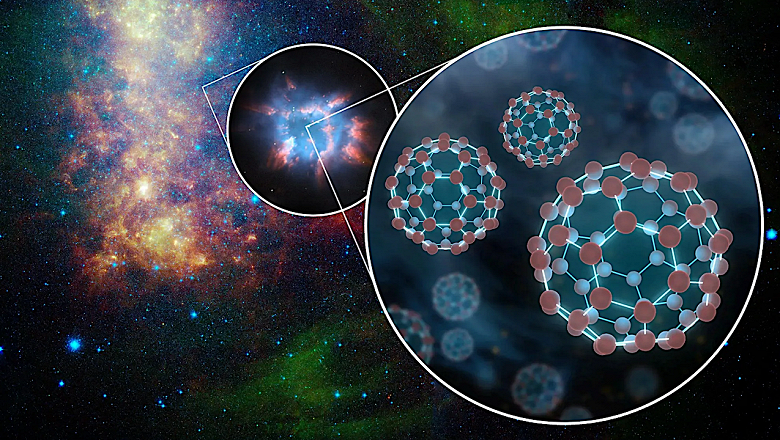Huge carbon structures fill the space environment
Using NASA's Hubble Space Telescope, scientists were able to confirm the existence of electrically charged molecules shaped like footballs in space. This discovery brings us closer to solving the mystery of the interstellar medium – the gas and dust that fills the space between stars.
“The interstellar medium is the starting point for chemical processes that lead to the formation of stars and planets. Studying the composition of this environment provides information about the available ingredients to create stars and planets,” said Martin Cordiner of the Catholic University of America in Washington. Cordiner works at NASA Goddard Space Flight Center and is the lead author of the study.
The molecules identified by Cordiner and his team are a form of carbon known as “buckminsterfullerene”, made up of 60 carbon atoms (C60) arranged in a sphere. C60 has been found on Earth in rare cases in rocks and minerals and can also appear in soot at high combustion temperatures.
C60 has previously been discovered in space, but this time the presence of an ionized version (positively charged) of C60 in the rarefied interstellar medium has been confirmed for the first time. C60 is ionized by ultraviolet radiation from stars, giving it a positive charge (C60+).
Historically, the tenuous interstellar medium was thought to be too harsh an environment for the formation of large molecules. Before the discovery of C60, the largest known molecule in space was a molecule just 12 atoms in size. The discovery of C60+ in this environment shows how complex astrochemistry can be, even in very low-density, high-ultraviolet environments.
Life as we know it is based on carbon-based molecules, and this discovery shows that complex carbon molecules can form and persist in the harsh environment of interstellar space.
“In a sense, life can be considered the extreme degree of chemical complexity. The presence of C60 demonstrates the high level of chemical complexity inherent in space environments and indicates a greater likelihood of other complex carbon-based molecules occurring in space,” Cordiner said.
Most of the interstellar medium consists of hydrogen and helium, but it also contains many unknown compounds. To study the composition of this environment, scientists analyze the light of distant stars. As this light passes through the interstellar medium, various elements and compounds absorb and block certain wavelengths of light. Each element or compound has a unique absorption spectrum that allows it to be identified. However, some absorption spectra in the interstellar medium have features that do not match those of known atoms or molecules. These absorption spectra are called diffuse interstellar absorption bands (DIBs). Their identity has remained a mystery since astronomer Mary Lee Heger published observations of the first two DIBs in 1922. The discovery of C60+ in the interstellar medium helps to understand the origin of these mysterious DIBs.
DIB can be determined by accurately matching the substance's fingerprint in the absorption lines in the spectrum. However, there are millions of different molecular structures that need to be tested, all of which would require many lifetimes.
“There are now more than 400 DIBs known, and with the exception of C60+, none have been clearly identified,” Cordiner said.
Decades of laboratory research had failed to produce an exact match to any DIB until the C60+ work, and recent research with the Hubble Space Telescope has yielded breakthroughs in understanding these mysterious absorption bands. In this work, the team was able to match the absorption spectrum from C60+ in the laboratory with Hubble observations, testing a benchmark proposed by a team from the University of Basel in Switzerland in laboratory studies.
A big challenge in detecting C60+ using ground-based telescopes is that atmospheric water vapor blocks the view of C60+'s absorption spectrum. However, being in space above most of the atmosphere, the Hubble telescope has a clear view. However, scientists still had to greatly exceed the telescope's normal sensitivity limits to be able to detect the faint fingerprints of C60+. The results of this study represent an important step in determining the origin of DIB and expand our understanding of the chemical complexity of cosmic environments.
The observed stars in which C60+ was detected are blue supergiants located in the plane of the Milky Way. The interstellar material of the Milky Way is mostly located in a relatively flat disk, so observation lines in the galactic plane pass through the largest amount of interstellar material and exhibit the brightest absorption lines.
The discovery of C60+ in the tenuous interstellar medium confirms that complex carbon-based molecules can form and persist even in the harsh conditions of interstellar space. Large carbon-containing molecules are likely candidates to explain many of the remaining unidentified DIBs, and future laboratory studies will help identify some of the remaining DIBs.

